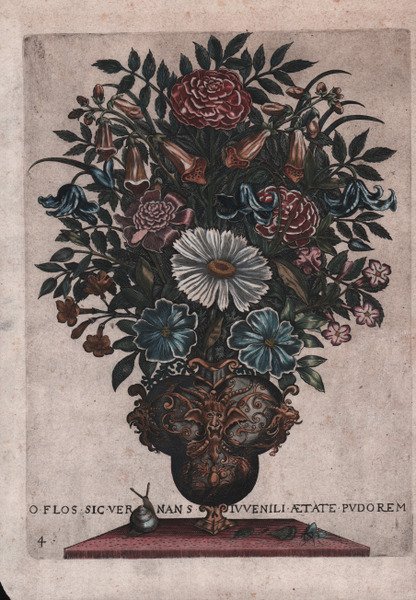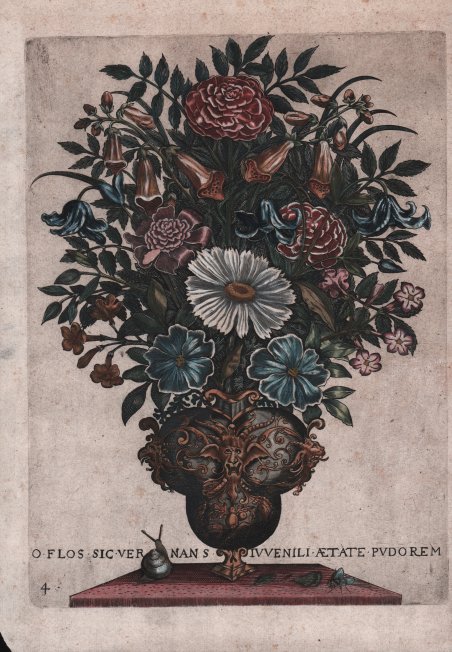Un vaso con fiori su un tavolo, con una mosca e una lumaca, il vaso decorato con la testa di una creatura demoniaca; copia di un bulino di Johann-Theodor de Bry da un soggetto di Jacob Kempener. Bulino, circa 1600/1620, privo di firma ed indicazioni editoriali. L’opera appartiene alla serie Sei mazzi di fiori in vaso. Numerata e firmata negli angoli inferiori: "4". Sotto l'immagine, in un nastro, iscrizione latina: "O Flos sic Vernans Ivvenili ætate Pvdorem.". Sebbene non firmata crediamo che sia una delle copie che l’editore Filippo Succhielli (editore attivo tra il 1580 e il 1620) pubblica in Siena nei primi anni del XVII secolo. Copia in controparte dell’incisione che Jan Sadeler pubblica a Venezia tra il 1597 e il 1600 https://www.antiquarius.it/it/scuola-fiamminga-del-xvi-secolo/13507-o-flos-sic-vernans-iuvenili-aetate-pudorem.html “Appartiene a una serie di sei copie a grandezza naturale e rovesciate della serie di incisioni di Johann-Theodor de Bry dopo Jacob Kempener (Hollstein nn. 451-56). La serie è stata prodotta in un periodo compreso tra l'arrivo di Jan Sadeler a Venezia nel 1596/7 e la sua morte nel 1600. Se si confrontano le copie di Sadeler con gli originali di De Bry, si può notare una leggera semplificazione e la rinuncia ai bordi ornamentali che caratterizzano gli originali. Sebbene in queste copie le iscrizioni siano collocate sotto gli stessi vasi di fiori di De Bry, l'ordine numerico è stato modificato. Un'altra serie di copie fu pubblicata da Jean Messager e Jean Picquet intorno al 1620. Il ruolo dei Sadeler, stabilitisi a Venezia nel 1596 o 1597, fu importante, poiché portarono in città nuovi approcci e nuovi generi alla stampa. Questa serie di fiori in vaso ebbe un ruolo molto importante nell'introdurre una nuova categoria di soggetti e fu subito molto influente. Le serie di copie con gli indirizzi di Filippo Succhielli e Pietro Paolo Tozzi ne sono un’indicazione. La serie Tozzi di 6 esemplari (300 x 230 mm circa), di cui uno con indirizzo "Pietro Paolo Tozzi formis Padova", è approssimativa e spesso sommaria, con molti errori nella trascrizione delle iscrizioni latine. Una serie di otto esemplari, compresi i sei di Sadeler, è stata pubblicata da Succhielli a Siena. Esiste anche una serie di copie in formato ridotto (192 x 145 mm) pubblicate da uno della famiglia Sadeler. Nel Nord esisteva una tradizione di dipinti di fiori in vaso, che può essere fatta risalire almeno all'opera di Ludger Tom Ring il Giovane a Münster; una delle sue opere è datata 1562. Le stampe di Theodore de Bry da Kempener, purtroppo non datate, furono innovative nell'introduzione del soggetto nella grafica. I bordi ornamentali di questa serie originale indicano che erano state concepite come stampe da incorniciare e appendere al muro. In tutti i dipinti i fiori sono disposti in modo da stabilire un forte grado di simmetria laterale: quella che Bergström chiamava composizione radiale. I vasi sono molto elaborati, ognuno è un'invenzione a sé stante, e si inseriscono nella tradizione delle serie di stampe di vasi che inizia con Agostino Veneziano (Bartsch XIV.387.541-552). Ci si chiede se le iscrizioni siano significative. Esse percorrono abilmente la declinazione della parola Flos, che in latino significa fiore. Nella presente serie di copie, la n. 5, con la sua iscrizione sulla fugacità del fiore che ci ricorda il nostro invecchiamento, ha fiori che sembrano troppo gonfi. Il n. 3, invece, con il suo riferimento alla tenerezza della giovinezza come alla tenerezza dei fiori, presenta boccioli e fiori che si stanno appena schiudendo, accanto a quelli già aperti. È interessante il fatto che ai fiori vengono attribuiti diversi tipi di significati, non solo per ricordarci monotonamente la nostra mortalità. Il n. 4, ad esempio, contiene l'ingiunzione di imparare dal fiore a vivere decentemente (A FIORE ACCIPIAS HONESTE VIVERE DISCAS), che potrebbe essere un riferimento al Discorso della Montagna (M. A vase with flowers on a table, with a fly and a snail, the vase decorated with the head of a demonic creature; copy in reverse after Johann-Theodor de Bry who engraved after Jacob Kempener. Engraving, ca. 1600/1620, lacking signature and printing details. The work belongs to the series Six Bouquets of Flowers in Vases. Numbered and signed in the lower corners: "4." Below the image, in a ribbon, Latin inscription: "O Flos sic Vernans Ivvenili ætate Pvdorem." Although unsigned we believe this is one of the copies that the publisher Filippo Succhielli (publisher active between 1580 and 1620) published in Siena in the early 17th century. Counterpart copy of the engraving that Jan Sadeler published in Venice between 1597 and 1600 https://www.antiquarius.it/en/xvi-century-flemish-school/13507-o-flos-sic-vernans-iuvenili-aetate-pudorem-.html “This belongs to a set of six full-sized, reversed copies of Johann-Theodor de Bry's series of engravings after Jacob Kempener (Hollstein nos.451-56). The set will have been produced at some time between Jan Sadeler's arrival in Venice in 1596/7 and his death in 1600. When the Sadeler copies are compared with De Bry's originals it can be seen that a slight simplification has taken place and that they dispense with the ornamental borders which are a marked feature of the originals. Although in these copies the inscriptions are placed beneath the same vases of flowers as in De Bry's, the numerical order has been changed. Another set of copies was published by Jean Messager and Jean Picquet c.1620. The role of the Sadelers who settled in Venice in 1596 or 1597 was an important one, for they brought into the city new approaches to printmaking and new genres of print. This series of flowers in vases had a very important role in introducing a new category of subject matter, and they were immediately very influential. Sets of copies bearing the addresses of Filippo Succhiello and Pietro Paolo Tozzi are an indication of that. The Tozzi series of 6 (300 x 230 mm approx.) one of them with address 'Pietro Paolo tozzi formis Padua' are rough and often perfunctory, with many mistakes in the transcriptions of the Latin inscriptions. A set of eight, including the six of Sadeler, was published by Succhielli in Siena (Cleri and Paoli, 1992, pp.74-81 and 139; in the inventory of the Urbania collection, p.139, the designs are said to be of Francesco Curti). There was also a set of reduced-size (192 x 145 mm) copies published by one of the Sadelers. These mix up the inscriptions, applying them to vases of flowers for which they were not originally intended (de Jong and de Groot, 1988, p.183, no.355); it should be noted that in the 29 May 1600 agreement between Jan and Raphael Sadeler there is a mention of a book of 13 plates with flowers. There was in the North a tradition of paintings of flowers in vases, that can be traced back at least as far as the work of Ludger Tom Ring the Younger in Münster; one of his works is dated 1562. Theodore de Bry's prints after Kempener, which unfortunately are not dated, were innovative in introducing the subject into the graphic media. The ornamental borders of that original set indicate that they were conceived as prints to frame and hang on the wall. In all of them the flowers are arranged in such a way as to establish a strong degree of lateral symmetry: what Bergström called the 'radial composition' (Bergström, 1973, pp.22-26). The vases are very elaborate, each one being a separate invention, and fit with the tradition of series of prints of vases which starts with Agostino Veneziano (Bartsch XIV.387.541-552). The question arises whether the inscriptions are significant. They cleverly run through the declension of the word Flos, the Latin for flower. In the present set of copies, no. 5, with its inscription about the fugitiveness of the flower reminding us of our own ageing, has flowers that seem over-blown. On the other hand no.3, with its reference to the. Cfr.


Scopri come utilizzare
Scopri come utilizzare

